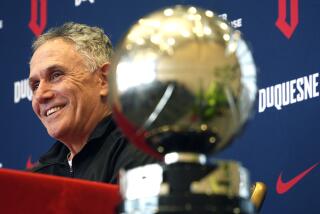Covered in Glory
- Share via
Before Kobe Bryant made the jump to the big time, before Dajuan Wagner scored 100 points in a high school game, before LeBron James appeared on national television and the cover of Sports Illustrated, way before any of this, there was the original.
He played to overflow crowds at the 2,200-seat gym in Lebanon, Ind., Rick Mount did, drilling shot after shot for Lebanon High.
He was textbook before a text had been written, learning by repetition, shooting for hours at Memorial Park as little kids fought to get the ball back to him.
He rode in convertibles in Fourth of July parades and was the treasure in a town of fewer than 10,000 people 25 miles northwest of Indianapolis.
It was Feb. 14, 1966, when Mount stopped being Lebanon’s little secret and became the first male high school team athlete to appear on the cover of Sports Illustrated. It changed his life, throwing him into mailboxes from Orono, Maine, to Orange County, and raised expectations that he had been able to fulfill only partially when his pro career came to an abrupt, uninspiring end with the Utah Stars in the old American Basketball Assn. in 1975.
James, whose next tour stop is Saturday night at Pauley Pavilion against Santa Ana Mater Dei, was on the cover of Sports Illustrated last February. He was photographed clutching a golden basketball, with the words “The Chosen One” practically predicting a nine-time NBA All-Star run for the senior from St. Vincent-St. Mary’s High in Akron, Ohio.
Mount’s cover photo better fit his era, a softer snapshot taken in front of a barn in Boone County, imprinting upon a national readership the notion of a sweet-shooting small-town Hoosier kid years before Larry Bird arrived on the scene.
“I had a lot of statewide publicity already,” Mount said. “And then when that article came out, it gave me national prominence.”
Life since that Sports Illustrated cover has been a series of three-pointers and airballs for Mount.
He was a three-time All-American at Purdue, but he never approached his amateur achievements in pro ball, spending a humble five-year ABA career with four teams.
He stumbled as a post-basketball businessman and later sparred with Purdue over the treatment of his famed, but not retired, No. 10 jersey, making some people wonder what happened to the kid they used to call Mount Lebanon.
He now lives less than a block from where he grew up, mere miles from the red barn in the photo.
*
Mount, with his trademark blond flat-top haircut, was purity and poetry with the ball, his 6-foot-4 frame and strong leaping ability a perfect combination for his jump shot.
He was the king of the medium-range jumper, drilling 17-footers near the top of the key, on the wing and from the baseline.
“There’s that old image of a country kid shooting on a basketball backboard nailed to a barn door, with snowflakes coming down,” said Bob King, Mount’s coach at Purdue. “That’s Rick Mount. That’s Indiana basketball.”
Mount was Indiana’s high school Mr. Basketball in 1966 and became Purdue’s all-time leading scorer during a different time in college basketball.
Dunking was not allowed. The three-point line did not exist. College players stayed all four years and played only three -- freshmen, ineligible for varsity competition, spent a mandatory year on their own team.
Lucrative sponsorship deals from sneaker companies were nonexistent. NCAA games were televised regionally, if that, until the tournament, which included only 25 teams.
More relaxed rules let college coaches recruit whenever they wanted, allowing them to flock to Memory Hall to see the sweet-shooting kid in person.
“There were a lot of them coming through,” said Jim Rosenstihl, Mount’s coach at Lebanon. “I’d take them down to the dressing room after the game. I’d tell them before I went down there that I’d want them to shake some of these other players’ hands too. And they would. But Rick was the one they were interested in.”
Understandably.
Mount averaged 33.1 points in his final two years at Lebanon and finished with 2,595 points, still fourth in Indiana prep history.
Crawfordsville High, the host of a game against Lebanon in 1965, anticipated a large crowd and moved the game to the fieldhouse at Butler University in Indianapolis. More than 10,000 people attended. The school made enough money to buy a bus.
After high school, Mount originally committed to Miami. Then he realized that basketball there was secondary, perhaps tertiary, behind football and sunbathing. He never enrolled and instead went 35 miles away to Purdue, which had quietly kept open a scholarship in case Mount changed his mind.
At Purdue, Mount averaged 32.3 points in his three-year career and was Big Ten player of the year in 1969 and ’70. He is best known for his role in one of the more memorable NCAA tournament games, hitting a “leaping lofter,” as some observers called it, with two seconds left to beat Marquette in overtime, 75-73, sending the Boilermakers to the 1969 Final Four.
They would lose to UCLA in the title game, 92-72. Mount scored 28 points but missed 24 of 36 shots.
Mount will be 56 on Sunday, and still the late-night phone calls come, unfamiliar voices waking him from his sleep, slurring and yelling at him from a bar in Wisconsin or Ohio or Illinois, demanding an answer to settle a bet: “How many points did you score that night against Iowa?”
Mount, whose phone number has always been listed, gives the answer, 61, briefly listens to the glee or glumness, then goes back to bed.
Not everything in Mount’s post-Purdue life has had such a tidy denouement.
He was average in the pros, initially signing with the ABA’s Indiana Pacers and starting at times, but never coming close to his college achievements. Mount was still able to score, but his defensive liabilities caught up to him, and the Pacers’ dream of local-boy-makes-good never materialized.
Mount was dealt to the Kentucky Colonels, and from there to ABA teams in Tennessee and Utah, averaging slightly less than 12 points over his career. He never played in the NBA.
When he was done with basketball -- a separated shoulder felled him for good as a pro -- he went home to Lebanon, a lost soul.
He sold insurance, then opened Rick Mount’s Sport Shop, an ill-fated enterprise that lasted less than five years. First-time shoppers were often befuddled. They’d come looking for basketballs or shoes, only to realize the store was dedicated to Mount’s lifelong passion for the outdoors. The store was filled with guns, bait and tackle, and had an indoor archery range, but no high-tops.
Mount tried to get a high school coaching job in Lafayette, but was rebuffed when it was revealed he had never attained his college degree.
“It was a mistake,” he says. “I should have went back when I was younger and got it.”
He never did, and remains 11 or 12 credits short.
His ties with Purdue also became strained.
Mount’s son, Rich, accepted a scholarship to play for the Boilermakers in 1988 but transferred to Virginia Commonwealth after one season, his shooting touch not quite as deft as his dad’s.
And Mount felt slighted when Purdue allowed guard Woody Austin to wear Mount’s No. 10 jersey in 1989. Although Purdue does not retire numbers -- not even the No. 13 of John Wooden, the 1932 national player of the year at Purdue -- Mount was offended.
“I never got that respect phone call from Purdue,” he said. “It kind of made me mad.”
Mount skipped several Purdue basketball reunions and was a no-show for his induction as a charter member of the Purdue Hall of Fame in 1994.
The rift has closed recently, partly because sophomore guard Brandon McKnight called Mount last year and asked if he could wear No. 10.
“I said, ‘Son, wear it with pride,’ ” said Mount, who set foot on the Purdue campus last year for the first time since Rich transferred. “It’s all working out.”
Purdue, in fact, is now among Mount’s customers for the “Shoot-A-Way” retrieval system, a device that returns a basketball down a track to a player after a shot.
Mount also does his part to keep alive the mid-range jumper, an art that has all but disappeared, he admits with a trace of despair.
Mount runs “shoot camps” each summer for high school players in Indiana, Ohio, Illinois and West Virginia. By the end of the three-day clinics, each player will have taken 2,500 supervised shots. There is no scrimmaging, only shooting.
Mount’s modern counterpart, James, has a blistering first step, superb body control in the air and a surreal sense of when to pass. One of the few knocks on him: His mid-range jumper isn’t well developed.
“To work on form, you’ve got to go out and shoot 400 or 500 jumpers a day,” Mount said. “You’re dealing with muscle memory. The jump shot kids bring to my camp, maybe there’s two or three things wrong. They’ve had it in their memory for four or five years. I’m trying to change their form.”
Mount is critical of most changes in high school basketball, particularly the heavy-handed sneaker sponsorship. He scoffs when he hears that James’ team, St. Vincent-St. Mary High, is financially sponsored by Adidas, with each player receiving free top-of-the-line shoes and apparel.
When Mount was in high school, he bought his own basketball shoes for $5. Or sometimes his coach would buy a pair for each player.
“There’s so much more out there than when I was in high school, with the shoe companies and all this hype,” Mount said. “James is in a position where he can make a lot of money [with endorsements]. I don’t like to see it, but I don’t blame him. I blame Nike. I blame Adidas. They’re in the business to make money and sell shoes.”
Mount offers his own shoe-deal story. He said Pro Keds offered him $40,000 to wear its new suede basketball shoe in 1970-71, his first season as a pro. Mount declined, saying he preferred Chuck Taylors, the canvas shoe from Converse.
One problem: Converse never came in with a sponsorship offer.
“I turned down 40 grand from Pro Keds. How stupid was I?” he said.
Money is less important now to Mount. He insists on being outdoors often, hunting turkey or deer. He has been married to his high school sweetheart, Donna, for 33 years, and his son has moved back to Lebanon, where he works as a police officer.
The memories of a young Rick Mount linger in Lebanon. His name still carries weight.
“When anybody talks about a Rick in Indiana,” King said, “you know who they’re talking about.”
More to Read
Go beyond the scoreboard
Get the latest on L.A.'s teams in the daily Sports Report newsletter.
You may occasionally receive promotional content from the Los Angeles Times.











